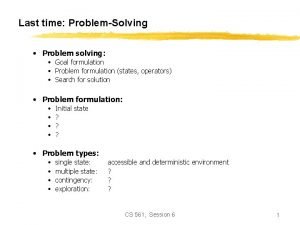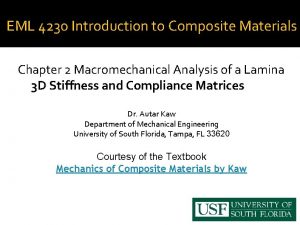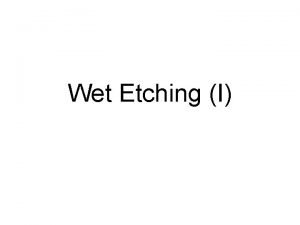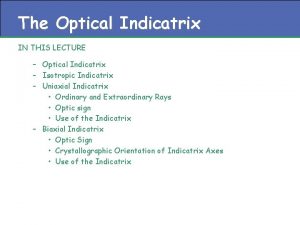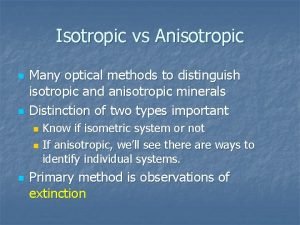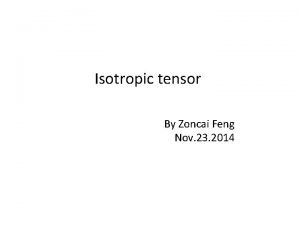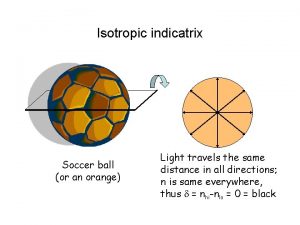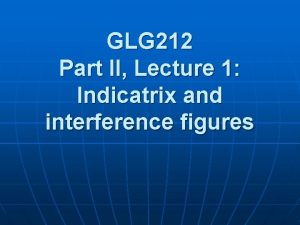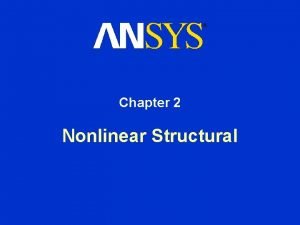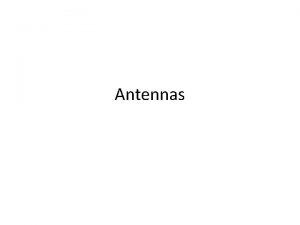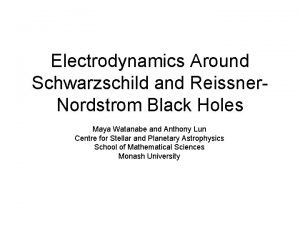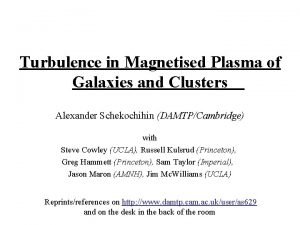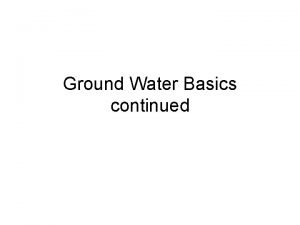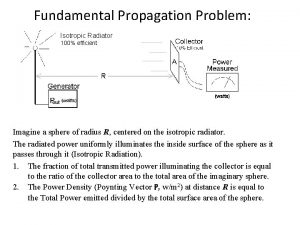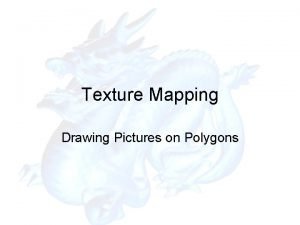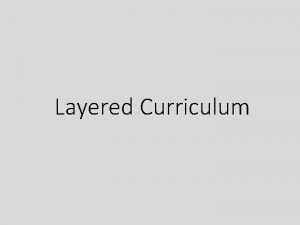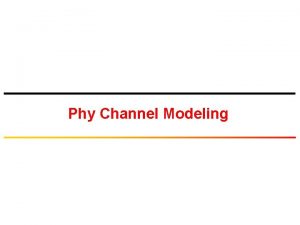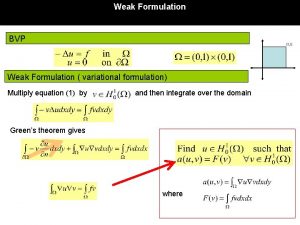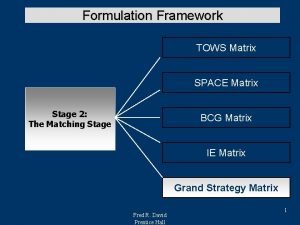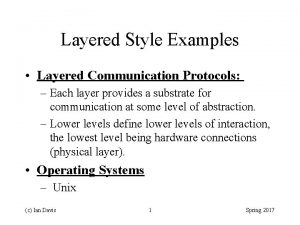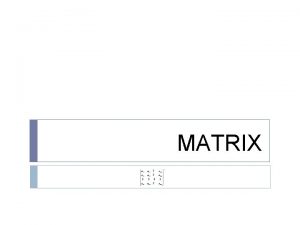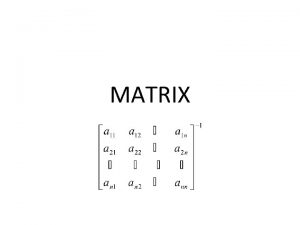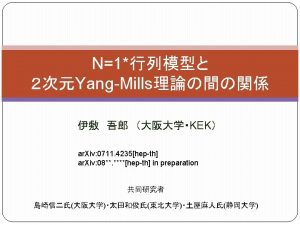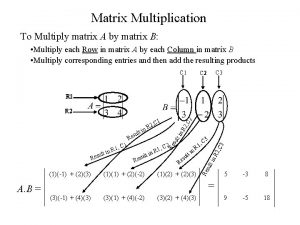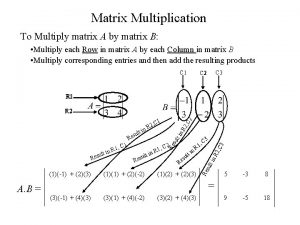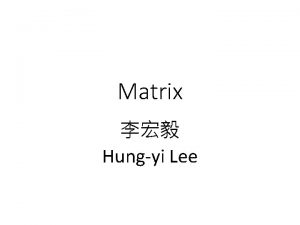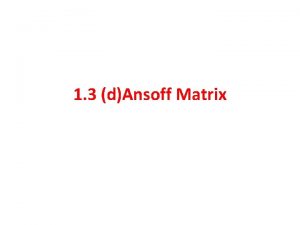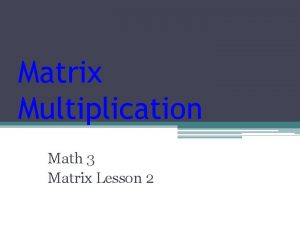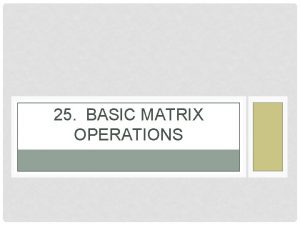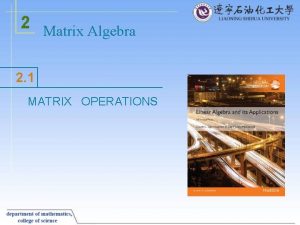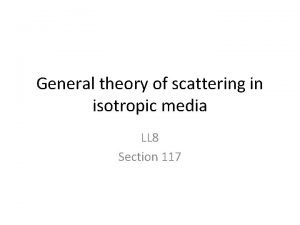Matrix Formulation for Isotropic Layered Media 2 2



























- Slides: 27

Matrix Formulation for Isotropic Layered Media

2Χ 2 Matrix Formulation For a Thin Film • The dielectric structure is described by • The electric field can be written as

2Χ 2 Matrix Formulation For a Thin Film • The electric field E(x) consists of a right-traveling wave and a left-traveling wave and can be written as • Let A(x) represent the amplitude of the right-traveling wave and B(x) be that of the left-traveling one.

2Χ 2 Matrix Formulation For a Thin Film • To illustrate the matrix method, we define

2Χ 2 Matrix Formulation For a Thin Film • If we represent the two amplitudes of E(x) as column vectors, the column vectors are related by

2Χ 2 Matrix Formulation For a Thin Film • D 1, D 2 and D 3 are the dynamical matrices and given by • Where α = 1, 2, 3

2Χ 2 Matrix Formulation For a Thin Film • The matrices D 12 and D 23 may be regards as transmission matrices that link the amplitude of the waves on the two sides of the interface and are given by

2Χ 2 Matrix Formulation For a Thin Film • The expression for D 23 are similar to those of D 12. • The equations can be written formally as

2Χ 2 Matrix Formulation For a Thin Film • The amplitudes are related by

2Χ 2 Matrix Formulation for Multilayer System • The multilayer structure can be described by

2Χ 2 Matrix Formulation for Multilayer System • The electric field distribution E(x) can be written as

2Χ 2 Matrix Formulation for Multilayer System • Using the same argument as in Section 5. 1. 1, we can write

2Χ 2 Matrix Formulation for Multilayer System • The matrices can be written as

2Χ 2 Matrix Formulation for Multilayer System • The relation between written as with the matrix given by can be

Transmittance and Reflectance • If the light is incident from medium 0, the reflection and transmission coefficients are defined as

Transmittance and Reflectance • Using the matrix equation and following definitions, we obtain • The reflectance and transmittance are

Example: Quarter-Wave Stack • We consider a layered medium consisting of N pairs of alternating quarter-waves l with refractive indices n 1 and n 2, respectly. Let n 0 by the index of refraction of the incident medium and ns be the index of refraction of the substrate.

Example: Quarter-Wave Stack • The reflectance R at normal incidence can be obtained as follows: The matrix is given by • The propagation matrix for quarter-wave layers(with φ=(1/2)π) is given by

Example: Quarter-Wave Stack • By using Eq. (5. 1 -23) for the dynamical matrices and assuming normal incidence, we obtain, after some matrix manipulation,

Example: Quarter-Wave Stack • Carrying out the matrix multiplication in Eq. (5. 2 -7) and using Eq. (5. 2 -5), the reflectance is • Reflectance of a Quarter-Wave Stack

General Theorems of Layered Media • The matrix elements Mij satisfy the relations provides n 1, n 2, n 3, and θ 1, θ 2 are real. • The propagation matrix Pl is a unimodular matrix

General Theorems of Layered Media • The matrix product is merely a transformation of the propagation matrix and is also unimodular. Thus, the determinant of the matrix M is very simple and given by

Left and Right Incidence Theorem • For a given dielectric structure defined by Eq. (5. 1 -16), the reflection and transmission coefficients defined by Eqs. (5. 2 -1) and (5. 2 -2), respectively, may be considered as function of β:

Left and Right Incidence Theorem • Let r’ and t’ be the reflection and transmission coefficients, respectively, when light is incident from the right side with the same β.

Left and Right Incidence Theorem • Let T and T’ be the transmittances of the layered structure when light is incident from the left medium and right medium. These two transmittances are given by • Using Eq. (5. 3 -8) and the expression for |M| in Eq. (5. 3 -3), we obtain

Principles of Reversibility • For the case of a dielectric multilayer structure with real index of refraction, the functional relations between these four coefficients (r, t, r’, t’) can be obtained

Conservation of Energy • In the case when all the layers and the bounding media are pure dielectrics with real n, the conservation of energy requires that R+T=1
 Why problem formulation follow goal formulation
Why problem formulation follow goal formulation Isotropic compliance matrix
Isotropic compliance matrix Effective isotropic radiated power
Effective isotropic radiated power Etching meaning in chemistry
Etching meaning in chemistry Weber's least cost theory
Weber's least cost theory Biaxial indicatrix
Biaxial indicatrix Isotropic vs anisotropic minerals
Isotropic vs anisotropic minerals Isotropic tensor example
Isotropic tensor example Isotropic indicatrix
Isotropic indicatrix Uniaxial indicatrix
Uniaxial indicatrix Etch undercut
Etch undercut Effective isotropic radiated power
Effective isotropic radiated power Ansys multilinear isotropic hardening
Ansys multilinear isotropic hardening What is a balun
What is a balun Schwarzschild isotropic coordinates
Schwarzschild isotropic coordinates Isotropic
Isotropic Aridic
Aridic Effective aperture of antenna
Effective aperture of antenna Polygon texture
Polygon texture Is quartz uniaxial or biaxial
Is quartz uniaxial or biaxial Iso 22301 utbildning
Iso 22301 utbildning Typiska drag för en novell
Typiska drag för en novell Nationell inriktning för artificiell intelligens
Nationell inriktning för artificiell intelligens Vad står k.r.å.k.a.n för
Vad står k.r.å.k.a.n för Varför kallas perioden 1918-1939 för mellankrigstiden
Varför kallas perioden 1918-1939 för mellankrigstiden En lathund för arbete med kontinuitetshantering
En lathund för arbete med kontinuitetshantering Adressändring ideell förening
Adressändring ideell förening Tidbok yrkesförare
Tidbok yrkesförare
